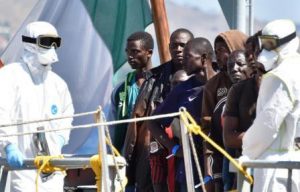A Look at Media Coverage of the European Migration Crisis


[/media-credit] Migrants wait to disembark from the Irish Navy vessel LE Niamh at the Messina harbor in Sicily, Italy, Monday, Aug. 24, 2015.
In order to properly analyze the media coverage of this issue, this first article aims to provide a very general overview of the ongoing crisis. While the complexity of the migration crisis cannot be overstated, certain key facts can present information essential to beginning to understand the magnitude of this catastrophe.
The media coverage analyzed in this article is from French-speaking media sources in order to represent this widely used, the official language of many African countries. French-speaking media sources are also particularly relevant to the subject of African migration to Europe.
The influx of African and Middle Eastern migrants to European countries has led to an escalating crisis throughout recent years. Both the scale of the crisis and its manifold consequences are simply unimaginable.
Thousands of men, women, and children have died in their attempted crossing of the Mediterranean, and those who have survived the journey have been met with further obstacles: unsafe holding conditions, susceptibility to falling victim to human trafficking, and refusal to be granted asylum. Effective solutions have yet to be found for addressing the scope of humanitarian, economic, and geopolitical issues contributing to this long-term wave of migration.
How many people?
According to the International Organization for Migration(IOM) , 680,928 men, women, and children have arrived on European territory by crossing the Mediterranean Sea in 2015. Currently, for the year, 3,175 men, women, and children have died or gone missing in their attempted crossing of the Mediterranean.
Currently, the number of arrivals and attempted crossings is dramatically increasing. The Greek island of Lesvos alone received an estimated total of 27,000 migrants during a single weekend in mid-October.
Of the known 3,175 men, women, and children who have died at sea, 2,822 have lost their lives in the Channel of Sicily. 335 have lost their lives trying to reach Greek islands, and 29 are known to have lost their lives trying to reach Spain.
Consistent statistics about the numbers of migrants from specific countries are difficult to establish, but the top nationalities represented among the migrants are from (in order): Syria, Afghanistan, Eritrea, and Kosovo.
Why migrate?
A number of ongoing conflicts and refugee crises in African and Middle Eastern nations have led many individuals and families to seek asylum in Europe. Migrants come from a variety of different nations and ethnic backgrounds, and specific information about their motivations for migration is established on a case-by-case basis. Overall, it is understood that they are fleeing wars, other violent conflicts, and persecution in their countries of origin.
According to the UN High Commissioner for Refugees(UNHCR), the vast majority of the Mediterranean Sea arrivals are originally from the world’s top ten “refugee-producing countries”: Syria, Afghanistan, Eritrea, Iraq, Somalia, Sudan, Nigeria, Pakistan, Gambia, and Bangladesh.
What now?
The world’s migration and refugee agencies have mobilized in order to address this officially declared humanitarian crisis. The IOM, UNHCR, and Amnesty International are among the largest agencies orchestrating vast relief efforts. The responses of individual European governments are mired in politics, and the European Union is under harsh global criticism for its inability to effectively address this crisis.
Because the vast majority of migrants first arrive on Italian territory, the Italian government funded and organized a year-long border surveillance rescue mission called Operation Mare Nostrum beginning in October 2013. Because the scale of the crisis increased so dramatically within that year, other European nations were called upon for voluntary contributions to the border surveillance and rescue efforts. The result of these contributions is Operation Triton, which first began in November 2014.
Operation Triton is conducted by Frontex, which is the European Union’s border security agency. Operation Triton’s budget is approximately one-third of that allotted for Mare Nostrum, and according to IOM, nine times as many deaths at sea have occurred since Operation Triton began. Media outlets have raised awareness about this devastating trend, and efforts in humanitarian crisis management continue to mount.
